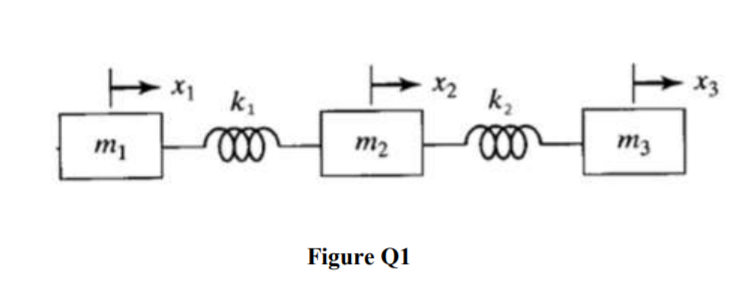Q1 The frequency equation of a 3 Degree of Freedom spring mass system (Figure Q1) is given as: m³w6 – 4km²aw4 + 3k?mw² = 0 where the value of the mass, m = 0.1 kg and spring stiffness coefficient, k = 10 N/m. By performing your calculation (final answer in 3 decimal points): Determine the most positive roots of the system, wusing Bisection Method. Use initial value of [4+(0.1*A), 12+(B/2)]. Iterate until 5th iteration. (a) (b) Determine the most positive roots of the system, w using Secant Method. Use initial value of [4+(0.1*A), 12+(B/2)]. Iterate until 5th iteration. The exact value of the most positive roots, w is given as 10 rad/s. Based from your answer in Q1(a) and Q1(b), identify its percentage relative error and justify which method is more accurate. (c)
Q1 The frequency equation of a 3 Degree of Freedom spring mass system (Figure Q1) is given as: m³w6 – 4km²aw4 + 3k?mw² = 0 where the value of the mass, m = 0.1 kg and spring stiffness coefficient, k = 10 N/m. By performing your calculation (final answer in 3 decimal points): Determine the most positive roots of the system, wusing Bisection Method. Use initial value of [4+(0.1*A), 12+(B/2)]. Iterate until 5th iteration. (a) (b) Determine the most positive roots of the system, w using Secant Method. Use initial value of [4+(0.1*A), 12+(B/2)]. Iterate until 5th iteration. The exact value of the most positive roots, w is given as 10 rad/s. Based from your answer in Q1(a) and Q1(b), identify its percentage relative error and justify which method is more accurate. (c)
Linear Algebra: A Modern Introduction
4th Edition
ISBN:9781285463247
Author:David Poole
Publisher:David Poole
Chapter2: Systems Of Linear Equations
Section2.4: Applications
Problem 17EQ
Related questions
Question
USE A=1
B=8
![Q1
The frequency equation of a 3 Degree of Freedom spring mass system (Figure Q1) is given
as:
m³w6 – 4km²w4 + 3k²mw² = 0
where the value of the mass, m= 0.1 kg and spring stiffness coefficient, k= 10 N/m.
By performing your calculation (final answer in 3 decimal points):
(а)
Determine the most positive roots of the system, wusing Bisection Method. Use initial
value of [4+(0.1*A), 12+(B/2)]. Iterate until 5th iteration.
(b)
Determine the most positive roots of the system, w using Secant Method. Use initial
value of [4+(0.1*A), 12+(B/2)]. Iterate until 5th iteration.
The exact value of the most positive roots, w is given as 10 rad/s. Based from your
answer in Q1(a) and Q1(b), identify its percentage relative error and justify which
method is more accurate.
(c)
NOTE: A is the 5th digit of your matric number and B is the 6th digit of your matric
number. If happen to be the 5th or 6th digit of your matric number (A or B) = 0, take
10 as the replacement value. Do not use 0 number. For example, if your matric number
is AD070102, use A = 10 and B= 2 and the initial value would be [5, 13].](/v2/_next/image?url=https%3A%2F%2Fcontent.bartleby.com%2Fqna-images%2Fquestion%2F9126547c-acd1-40cf-b247-1dea65405f3b%2F97e56f27-a235-4e8a-8b88-e34803f4aa7d%2F1ueerv_processed.png&w=3840&q=75)
Transcribed Image Text:Q1
The frequency equation of a 3 Degree of Freedom spring mass system (Figure Q1) is given
as:
m³w6 – 4km²w4 + 3k²mw² = 0
where the value of the mass, m= 0.1 kg and spring stiffness coefficient, k= 10 N/m.
By performing your calculation (final answer in 3 decimal points):
(а)
Determine the most positive roots of the system, wusing Bisection Method. Use initial
value of [4+(0.1*A), 12+(B/2)]. Iterate until 5th iteration.
(b)
Determine the most positive roots of the system, w using Secant Method. Use initial
value of [4+(0.1*A), 12+(B/2)]. Iterate until 5th iteration.
The exact value of the most positive roots, w is given as 10 rad/s. Based from your
answer in Q1(a) and Q1(b), identify its percentage relative error and justify which
method is more accurate.
(c)
NOTE: A is the 5th digit of your matric number and B is the 6th digit of your matric
number. If happen to be the 5th or 6th digit of your matric number (A or B) = 0, take
10 as the replacement value. Do not use 0 number. For example, if your matric number
is AD070102, use A = 10 and B= 2 and the initial value would be [5, 13].

Transcribed Image Text:X2 k2
X3
X1
m2
m3
Figure Q1
Expert Solution
This question has been solved!
Explore an expertly crafted, step-by-step solution for a thorough understanding of key concepts.
Step by step
Solved in 4 steps with 5 images

Recommended textbooks for you

Linear Algebra: A Modern Introduction
Algebra
ISBN:
9781285463247
Author:
David Poole
Publisher:
Cengage Learning

Algebra & Trigonometry with Analytic Geometry
Algebra
ISBN:
9781133382119
Author:
Swokowski
Publisher:
Cengage

Linear Algebra: A Modern Introduction
Algebra
ISBN:
9781285463247
Author:
David Poole
Publisher:
Cengage Learning

Algebra & Trigonometry with Analytic Geometry
Algebra
ISBN:
9781133382119
Author:
Swokowski
Publisher:
Cengage